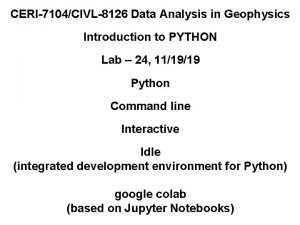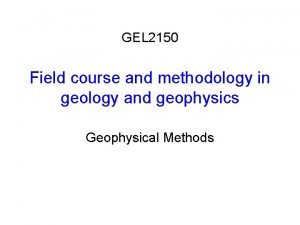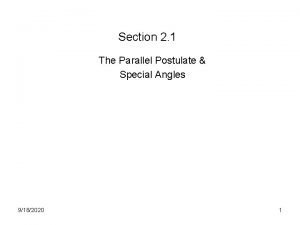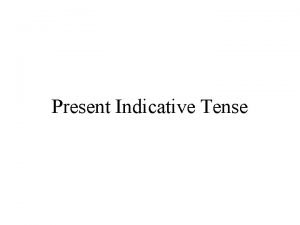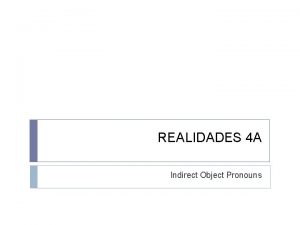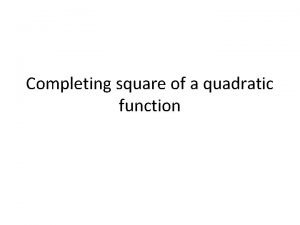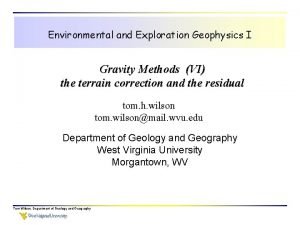Environmental and Exploration Geophysics I Magnetic Methods continued




































- Slides: 36

Environmental and Exploration Geophysics I Magnetic Methods- continued tom. h. wilson tom. wilson@mail. wvu. edu Department of Geology and Geography West Virginia University Morgantown, WV

Recall that the proton precession magnetometer makes measurements of the total field, not the vector components of the field. Recall also that the total field can be derived from other magnetic elements. The formula below represents the anomalous total field in terms of the horizontal and vertical components of the anomalous field.

Remember how the proton precession magnetometer works. Protons precess about the earth’s total field with a frequency directly proportional to the earth’s field strength The proton precession magnetometer measures the scalar magnitude of the earth’s main field.

In this diagram FET is is the vector sum of the earth’s main field and the anomalous field associated with a buried dipole field. The proton precession magnetometer measures the magnitude of FET.

Magnetic Elements for your location F is known

In summary - FAT is an approximation of T, the scalar difference obtained from measurements of the total field (FET) made by the proton precession magnetometer. For the purposes of modeling we work backwards. Given a certain object, we compute the horizontal (HA) and vertical (ZA) components of the anomaly and combine them to obtain FAT – an approximation of the anomaly we obtain from the proton precession magnetometer measurements – the total field anomaly.

The gradient is just the rate of change in some direction - i. e. it’s just a derivative. How would you evaluate the vertical gradient of the vertical component of the earth’s magnetic field?

The vertical gradient is just the variation of ZE with change in radius or distance from the center of the dipole.


Total Field Vertical Gradient http: //rubble. phys. ualberta. ca/~doug/G 221/Mag. Lecs/magrem. html

How would you evaluate the vertical gradient of the horizontal component of the earth’s magnetic field? Representing the earth’s horizontal field in dipole form as The vertical gradient is just the variation with change of radius or

Vertically polarized sphere or dipole Vertically polarized vertical cylinder Vertically polarized horizontal cylinder

Vertically polarized sphere or dipole Vertically polarized vertical cylinder Vertically polarized horizontal cylinder

These distances are referred to as diagnostic positions. Thus in the plot below the points along the x axis where the anomaly falls off to 3/4 ths, 2/3 rds, 1/2, 1/3 rd and 1/4 th of the maximum value of the anomaly are referred to as X 3/4, X 2/3, X 1/2, X 1/3 and X 1/4, respectively. X 1/3 X 2/3 X 1/2 X 1/4

Those measurements provide us with the above table. In this case we have distances in multiples of x/z.

In working with an actual anomaly, we can measure the actual distances to points where a given anomaly drops to various fractions of the maximum anomaly value and then compute the depth z.

We measure the distances (x) to the various diagnostic positions and then convert those x’s to z’s using the depth index multipliers which are just the reciprocal of the x/z values at which the anomaly drops to various fractions of the total anomaly magnitude.

Is a function of the unitless variable x/z The vertical field is often used to make a quick estimate of the magnitude of an object. This is fairly accurate as long as i is 60 or greater

X/Z Vertical Cylinder Sphere Horizontal Cylinder X 3/4 0. 46 0. 315 0. 31 X 1/2 0. 766 0. 5 0. 495 X 1/4 1. 23 0. 73 0. 68 Depth Index Multipliers Vertical Cylinder Sphere Horizontal Cylinder X 3/4 2. 17 3. 18 3. 23 X 1/2 1. 305 2 2. 02 X 1/4 0. 81 1. 37 1. 47

Sphere, Vertical Cylinder; ZSphere z = _____ The depth Diagnostic positions Multipliers Sphere Multipliers Cylinder X 3/4 =0. 9 3. 18 2. 17 X 1/2 =1. 55 2 1. 31 X 1/4 =2. 45 1. 37 0. 81 ZCylinder

Sphere or cylinder? Diagnostic positions Multipliers Sphere ZSphere Multipliers Cylinder X 3/4 = 1. 6 3. 18 2. 17 X 1/2 = 2. 5 2 1. 31 X 1/4 = 3. 7 1. 37 0. 81 ZCylinder

5. Given that derive an expression for the radius, where I = k. HE. Compute the depth to the top of the casing for the anomaly shown below, and then estimate the radius of the casing assuming k = 0. 1 and HE =55000 n. T. Zmax (62. 2 n. T from graph below) is the maximum vertical component of the anomalous field produced by the vertical casing.

The map view clearly indicates that consideration of two possible origins may be appropriate - sphere or vertical cylinder.

In general one will not make such extensive comparisons. You may use only one of the diagnostic positions, for example, the half-max (X 1/2) distance for an anomaly to quickly estimate depth if the object were a sphere or buried vertical cylinder…. Burger limits his discussion to half-maximum relationships. Breiner, 1973

You are asked to run a magnetic survey to detect a buried drum. What spacing do you use between observation points?

How often would you have to sample to detect this drum?

…. how about this one? The anomaly of the drum drops to ½ at a distance = ½ the depth.

Remember, the field of a buried drum can be approximated by the field of a dipole or buried sphere. X 1/2 for the sphere equals one-half the depth z to the center of the dipole. The halfwidth of the anomaly over any given drum will be approximately equal to its depth Or X 1/2 =Z/2


The sample rate you use will depend on the minimum depth of the objects you wish to find.


Sign Conventions Vectors that point down are positive. Vectors that point south are negative.

Original data The analytic signal


A 50 foot long drum? Drums in the bedrock?

 Python for geophysics
Python for geophysics Paul sava
Paul sava Gel geophysics
Gel geophysics Wireline geophysics
Wireline geophysics Coercivity
Coercivity Find flux
Find flux Magnetic moment and magnetic field relation
Magnetic moment and magnetic field relation Magnetic field and magnetic force
Magnetic field and magnetic force Magnetic field intensity
Magnetic field intensity Wireless health
Wireless health Revealed preference methods of environmental valuation
Revealed preference methods of environmental valuation Metal coping fpd
Metal coping fpd Romeo and juliet act iv continued
Romeo and juliet act iv continued Romeo and juliet consequences
Romeo and juliet consequences And they continued daily in the apostles doctrine
And they continued daily in the apostles doctrine Types of special angles
Types of special angles The verbs saber and conocer (continued)
The verbs saber and conocer (continued) Romeo and juliet act v continued
Romeo and juliet act v continued Capitulo 4a indirect object pronouns continued
Capitulo 4a indirect object pronouns continued Abbreviation of continued
Abbreviation of continued Example of signal word
Example of signal word Table continued
Table continued Continued abbreviation
Continued abbreviation Colon grammar
Colon grammar Demonstrative adjectives continued answers
Demonstrative adjectives continued answers Tu 1 of 1 montres tes photos? (us)
Tu 1 of 1 montres tes photos? (us) Compound adjectives list
Compound adjectives list Completing the square examples
Completing the square examples Factoring special products part 2
Factoring special products part 2 2-4 completing the square
2-4 completing the square Work and energy section 2 describing energy answer key
Work and energy section 2 describing energy answer key The four main layers of the atmosphere
The four main layers of the atmosphere Completing the square formula
Completing the square formula Chapter 8 section 3 cellular respiration
Chapter 8 section 3 cellular respiration Older television sets had tubes
Older television sets had tubes Completing the square (continued) quiz
Completing the square (continued) quiz Completing the square (continued)
Completing the square (continued)
